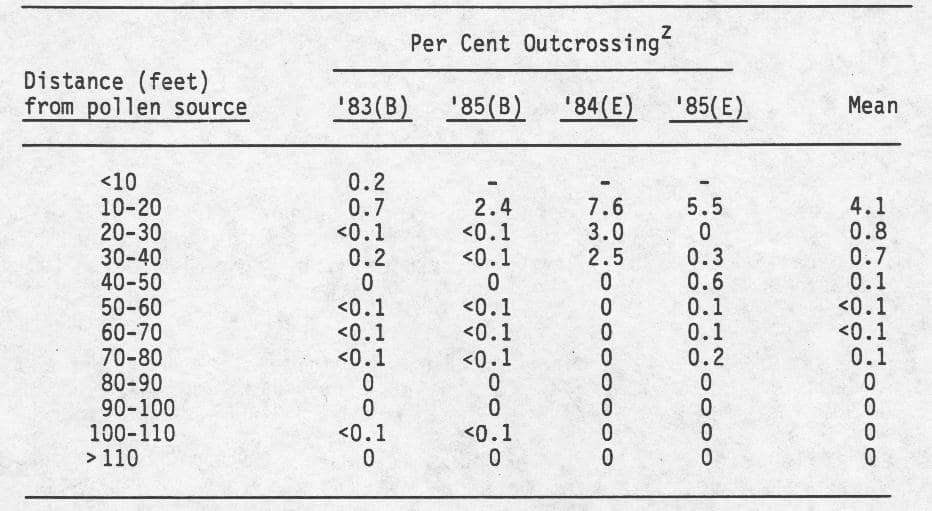Cucurbit Genetics Cooperative Report 10:66-68 (article 35) 1987
B.B. Rhodes
Edisto Research and Education Center, Clemson University Blackville, SC 29817
W.C. Adamson
USDA Southern Regional Plant Introduction Station Experiment, GA 30212
W.C. Bridges
Department of Experimental Statistics Clemson University, Clemson, SC 29634-0367
The minimum distance to prevent pollen transfer between watermelon plants is reported to be 0.25 mile (1). This distance is difficult to achieve when a large number of isolations are required on a small research station. This study attempted to estimate amount of pollen transfer by indigenous bees at distances less than 0.25 mile.
Studies of natural pollen transfer among watermelon plants were made in 1983, 1984 and 1985 at Blackville, SC and Experiment, GA. A dominant gene, Spotted (Sp) (2) was used to measure how much pollen was transferred and how far. From open pollinated fruit selected from specific field sites, seed were removed for scoring the dominant seedling marker. Usually more than 100 seedlings from each melon were scored at the third or fourth true leaf stage.
We attempted to design studies to address the following questions: (1) How far is pollen transferred? (2) What is the effect of interplanting muskmelons between the pollen source and the female parent? The following studies were conducted:
1983. At Blackville, 16-hill blocks of 13 watermelon varieties were alternated with 32-hill blocks of muskmelons in four replicates. This planting was actually a watermelon and muskmelon trial that lost a number of seedlings in several blocks after a late freeze. Missing hills were replaced by Sp seedlings. The location of each Sp plant was mapped. A watermelon block was isolated on two sides by muskmelons and on two sides by an unplanted strip 25 feet wide.
1984. At Experiment, eight plant introductions were replicated four times in blocks of eight watermelon plants buffered on each side by a ‘Butternut’ squash plant. Hills of watermelons were equidistant from a row of Sp plants alternating with ‘Butternut’ squash plants. After fruit set, the nearest distance from the melon to a pollen source was measured.
1985. Two studies were done – one at Blackville, SC and one at Experiment, GA.
At Blackville, four hills of the Sp line were planted inside a large block of ‘Crimson Sweet’, planted two feet-apart on the row, with rows ten feet apart. The nearest distance from Sp hills to ‘Crimson Sweet’ plants was 15 feet and the greatest distance was 125 feet. Seed were saved from fruit from each quadrant: 21, 32, 19 and 25 for quadrants NW, NE, SW and SE, respectively.
At Experiment, the study employed two blocks with 5 Sp plants in the center and watermelon PI’s planted at 12 and 48 feet from Sp in one block and at 12, 36 and 48 feet in the other block. Spaces between blocks were 15 feet apart within the row and 12 feet apart between rows.
The same four PI’s were planted at 12, 36 and 48 feet. There was only one set of plants at 12 feet, four sets of the PI’s at 36 feet and 8 sets of the PI’s at 48 feet.
To determine the effect of distance on per cent outcrossing, distances were first bracketed into 12 groups and means from each of the four data sets were considered replicates (Table 1). All four studies indicate that outcrossing is rare beyond 90 feet. The presence of a nearby bee hive could increase outcrossing.
To determine the effect of the muskmelon “barrier” in the 1985 Blackville field, outcrossing was compared within the block where the pollinator was located, in another block of watermelons separated only by a 25 foot unplanted area and in a watermelon block isolated from the pollinator by a block of muskmelons (Table 2). It is interesting that outcrossing occurred in only one case where watermelons were isolated by muskmelons. However, outcrossing percentages of 0.72, 0.72 and 1.01 were found in blocks of watermelons separated by two blocks of muskmelons. Thus, these small barriers are not sufficient to prevent outcrossing.
Where only natural bees are present, outcrossing beyond 80 feet appears to be rare. A final observation made with an entirely different genetic system supports this idea. In 1986, a block of several hundred male sterile watermelon plants were sited 450 feet from several hundred male fertile watermelon plants. Adjacent rows of male fertile plants were removed after the initial fruit set. Every fruit was then removed from male sterile plants. The male fertile plants produced pollen for three more weeks but none of the thousands of female blossoms on the male sterile plants were pollinated. One- fourth mile (1320 feet) is a generous isolation and, in most cases, half this distance is sufficient.
Table 1. Effect of distance from pollen source on per cent outcrossing in watermelon.

z Per cent of seedlings showing dominant Sp trait. (B) is Blackville, South Carolina location and (E) is Experiment, Georgia location.
Table 2. Per cent outcrossing within blocks of watermelons and among blocks isolated by unplanted blocks or muskmelon blocks.

z Four X 4-hill block of watermelons spaced 5 feet apart.
y Twenty-five feet wide.
x Eight X 4-hill block of muskmelons spaced 2.5 feet apart on the row with 5 feet between rows.
Literature Cited
- Lorenz, O.A. and D.N. Maynard. 1980. Knott’s Handbook for Vegetable Growers. 2nd Ed. p. 329.
- Rhodes, B.B. 1986. Genes affecting foliage color in watermelon. J. of Heredity 77:134-135.